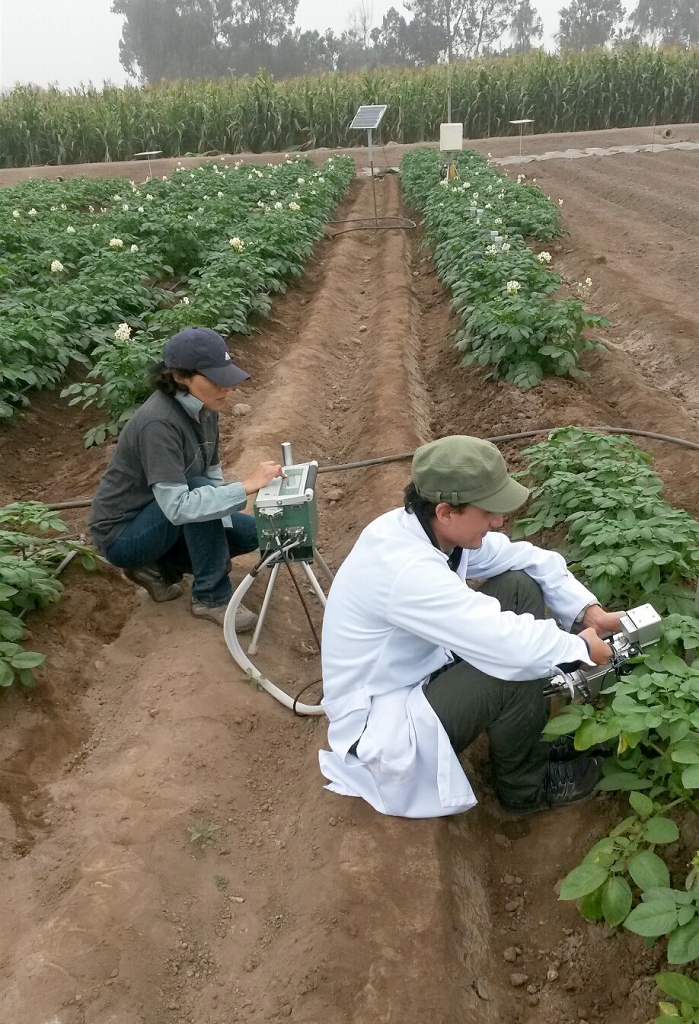Scientific innovation of CIP will make it possible to save water in potato cultivation
We will be able to grow potatoes in arid zones with effective use of water, without sacrificing productivity.
 Faced with the enormous challenge of producing potatoes in arid areas, the International Potato Center (CIP) is working simultaneously on two fronts. The first line of study is a technique known as Partial Root-Zone Drying (PRD), while the second subject of research has to do with planning when and how much to irrigate the crop based on the its physiological status.
Faced with the enormous challenge of producing potatoes in arid areas, the International Potato Center (CIP) is working simultaneously on two fronts. The first line of study is a technique known as Partial Root-Zone Drying (PRD), while the second subject of research has to do with planning when and how much to irrigate the crop based on the its physiological status.
These technological advances are particularly important in the present context of climate change, which threatens to intensify periods of drought in many parts of the developing world, where the potato is not only the sustenance of millions of families, but also an important source of income generation.
PRD consists, basically, in irrigating half of the root system of a crop while the other half is left dry. After a certain time, the dry half is irrigated, while the other already irrigated half is left to dry.
This method promotes the synthesis of Abscisic Acid (ABA) in the root zone in the dry section of soil. ABA is the hormone responsible for inducing tuber formation and for closing the leaves’ stomata or pores, which carry out the process of transpiration.
“The trick is to know when to apply alternate furrow irrigation, when to start and end PRD treatment, and what intensity of water restriction is the maximum that can be supported by the crop without affecting its carbon assimilation,” explains David Ramírez, CIP scientist and head of the Crop Ecophysiology and Modeling Laboratory, who admits that there is still a lot of research to be done in this reference.
This technique enables producers to save 30 to 50 percent of the water used, without significantly affecting tuber yield, according to field trials conducted by CIP in Peru, China, Uzbekistan and Ethiopia.
When and how much to irrigate
The second topic of research deals with establishing irrigation calendars by including certain physiological variables relating to the crop’s water status (physiological descriptors). The purpose is to fix irrigation times that will permit the optimization of water use, both under conditions of water deficit, and when water is available; this will help to identify those periods in which the well irrigated plants are supplied with the amount required to achieve higher yields.
One of the most widely accepted physiological descriptors is associated with the behavior of the pores or stomata of the leaves (stomatal conductance): the more the plants transpire, the greater will be the carbon fixation – since the activity of photosynthesis is extended – and the greater will be the yield.
“If the plants are working well, the amount of water lost through the stomata by transpiration is reflected in a reduction in the temperature of the leaves (rather like what happens with us: the more we perspire, the cooler we get),” explains Ramírez.
When water starts to become scarce, stomatal closure takes place, so the leaf temperature rises. The use of commercial thermal cameras capable of remote temperature estimation by capturing infrared radiation can be a good option for determining a crop’s water status. This could help us decide when we need to irrigate and establish irrigation calendars.
CIP has been working on this research through the project: “Effective water use in potato cultivation in arid areas: Improving irrigation management by monitoring the water status to address climate change,” funded by the World Bank through the National Agricultural Innovation Program (PNIA), and executed jointly with Universidad Nacional Agraria La Molina.
The overall project goal is to set in place physiological thresholds based on computerized modeling of different scenarios, to provide better tools for decision making regarding irrigation of the potato crop under different water conditions.
Potato cultivation requires 3500 to 6500 m3 of water per hectare, so it is a matter of some urgency that we find methods that will help to increase efficiency in the use of water without affecting the crop’s productivity. “It has been estimated that by 2050 there will be nineteen thousand two hundred million people in the world, which will increase the present water requirement threefold,” comments the specialist
“In the context of International Water Day, which draws people’s attention to this pressing issue confronting mankind (a problem that will only get worse as the population grows and climate change intensifies), we believe that projects such as those described definitely help us to find solutions, showing that science has a very important role to play in development,” concluded Ramírez.
